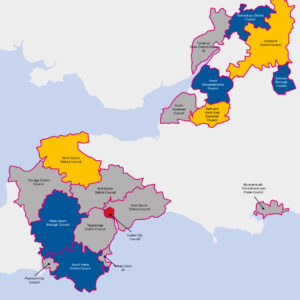For Labour, Jeremy Corbyn and his far-left agenda, the December General Election was the last attempt at power. Instead, as the exit poll predicted, Labour would lose. Hard.
With a defeated leader and vacant deputy position following the resignation of Tom Watson, Labour’s party leader and deputy must be replaced. The chosen successor must ensure that electoral prosperity can once again return Labour to the corridors of power.
In an electoral system where the ‘winner takes all’, the divided Official Opposition suffered at the hands of the electorate. The three candidates which remain, Sir Keir Starmer, Lisa Nandy and Rebecca Long Bailey, will face the party’s membership in this final round.
When determining who the next Leader should be, JBP has chosen three pieces of criteria to measure the candidates against.
- Support – the candidate should have the broadest and most tolerant support, both internal and external.
- History – both personal and professional, the next leader must be ‘clean’ and experienced to just the right amount.
- Electability – something that is as a result of 1) and 2), as leader of the Official Opposition, the new leader’s ultimate goal is to win an election.
Read below for a detailed analysis of the Labour Leadership contest as it stands.
We’ve also developed profiles on each of the candidates for the Leader and Deputy Leader elections – and you can find them here:
Support
This is the first and potentially most difficult to determine, because of the tendency to take the “Westminster Bubble” as gospel. To prevent this potential polarization, questions like: “Who from the Parliamentary Labour Party (PLP) have backed each candidate?”, “How does this relate to the Constituency Labour Party (CLP) and affiliate nominations?” and “What is the wider membership likely to do?” should be asked.
Looking at Labour’s last two leadership races, there was a direct conflict between the PLP and the party’s membership. Despite lacking support in Westminster, Jeremy Corbyn acceded to the ballot and then went on to win the 2015 race and fended off the PLP rebellion in 2016.
The 2016 election is indicative of the impact of a strong membership support network. Corbyn’s enhanced mobility, that was heavily influenced by splinter-group Momentum, demonstrates the power of a membership onboard and the benefit of an ‘on brand’ leader. Explicitly that they can get people to turn out and vote in numbers not seen in previous elections (especially for 18-24-year-olds). Their next step should be to transfer those votes into seats. Even in the last election, Jeremy Corbyn’s Labour secured more votes than in Tony Blair’s 2005 election victory, which secured him 355 seats.
Now, it is largely expected that Sir Keir Starmer and Rebecca Long Bailey will face one another in the final head-to-head, and so the focus will be on those two candidates. However, as mentioned, the most recent elections for the Labour leadership have been rather unpredictable and each of the remaining candidates, particularly Lisa Nandy, may yet prove to be a dark horse.
Sir Keir stormed into first place after gaining support from the greatest number of MPs and winning over half of the total number of nominations cast by CLPs and affiliates. Most notably, he has received the backing of several high-profile Labour MPs and affiliates. Such MPs include former Leader Ed Milliband, the Chair of the Exiting the EU Select Committee Hilary Benn and Chair of the Home Affairs Select Committee Yvette Cooper.
This list goes on to include other prominent figures such as Stephen Doughty, Ben Bradshaw and Dame Margaret Beckett. This group has a distinct centre ground-politics and are without doubt some of the more senior Labour parliamentarians, spreading across several of the past Labour governments.
When this is compared to Rebecca Long Bailey, you find a distinct difference which lays bare the divide within the Labour party. Long Bailey has been backed by more Shadow Cabinet members and more generally Corbyn supporters. These include John McDonnell, Diane Abbott, Angela Rayner, Barry Gardner, Richard Burgon and even the current leader, Jeremy Corbyn.
With endorsements from McDonnell naming her ‘the voice that we need’ and equally, Corbyn recommending Long Bailey as ‘our candidate’, this could gift Long Bailey the wider support of the membership, preferring continuity over a return to past times. There is no denying the impressive Corbyn movement and this could benefit Long Bailey and lead her to victory. She is an open and steadfast socialist and supporter of Corbyn (she backed Corbyn for leader twice) making her the ideal candidate and natural home for this faction of the party’s membership.
However, this could prove problematic. If there has been a rejection of the Corbyn project and ‘socialism’, as the last election indicates, these endorsement for Long Bailey could be extremely damaging. In fact, Long Bailey has already received the label ‘continuity Corbyn’ and looks set to become just that. A party’s membership can easily be an echo chamber, out of sync with the wider UK electorate. They are not necessarily synonymous. Indeed, Long Bailey sits distantly behind Sir Keir in CLP support and polling. This could be indicative of a membership move away from the status quo.
As it currently stands, Sir Keir has the support of 374 CLPs compared to Long Bailey’s 164. He also has more than double the number of affiliate and society nominations (16-7). Whilst important to ensure that the candidate makes it onto the ballot, it isn’t wholly representative for the full party membership, and when whittled down to a two-way choice, the political climate is volatile enough that it could see a shift entirely in Long Bailey’s favour.
Yet, after two disappointing election defeats, the once bitten tongues and tied hands of the Labour centre ground, may unsurprisingly be let loose in a retaliation. If and indeed should Lisa Nandy leave the race next, it is expected that Sir Keir would become the outright winner. However, this does not rule Long Bailey out, and she is certainly not to be underestimated.
History
The scrutiny usually endured by politicians over their personal and professional life, is heightened during any election. This leadership election is no different and each candidate’s skillset and background will impact on their ability to win. Both their pre-parliament and in-parliament careers will be instrumental in drawing support and there will inevitably be questions over policy intention.
Again, looking to Jeremy Corbyn as an example, his political career as a backbencher transcended to the Shadow front bench. His voting history, shared platforms and his personal political views on things like the monarchy, Trident and the EU have all plagued Corbyn’s front bench. They were raised during televised debates (including PMQs), various interviews and on the doorstep, and fundamentally turned moderate, centre ground and swing voters off.
Of course, qualification is objective. One person’s definition of qualified could be completely different to another’s. As both Sir Keir and Long Bailey have been in Parliament for the same time, their only difference is in their role. In normal circumstances, Long Bailey as Shadow Secretary of State for Business, Energy and Industrial Strategy might ‘outrank’ Starmer who, if it wasn’t for Brexit, may not even be in the Shadow Cabinet. However, these have not been normal times in British politics and as the Shadow Secretary of State for Exiting the European Union, Starmer has been immediately elevated. He has enjoyed greater airtime and frequent practice at holding the Government to account. Nevertheless, both share equal stature as Shadow Secretaries of State and so should be regarded as equal.
The more illustrative indicator should come from their lives pre-parliament. This would paint Sir Keir as the qualified candidate. His legal career, ended with his promotion to Director of Public Prosecution, Head of the Crown Prosecution Service and a Knighthood for his services to law and criminal justice.
Sir Keir represents the moderates in the Labour party. He voted in favour of the renewal of Trident along with 139 colleagues and resigned from the Shadow Cabinet in the wake of the European Union referendum. Sir Keir backed Owen Smith for Leader following mass resignations in Corbyn’s Shadow Cabinet in June 2015.
However, it is widely agreed that whilst Corbyn was an issue for voters, the Party’s position on Brexit was also difficult to swallow. Lifelong Labour voters in the North of England generally voted for Brexit. As Shadow Brexit Secretary, Starmer was instrumental in shaping the Party’s stance and is rumoured to have pushed strongly for a second referendum. Regardless of who is elected as leader, the party must win back the North from the Conservatives. Many historically safe seats turned Blue for the very first time in December and Starmer, if chosen, will have to justify that argument.
If elected Leader, Starmer has announced his support for freedom of movement, making ‘national wellbeing’ a priority and has distanced himself from several manifesto pledges including large-scale re-nationalisation. Starmer has also pledged for all-BAME shortlists and the formation of an independent body to investigate complaints. This would coincide with automatic bans for any clear-cut racism – a move to tackle anti-Semitism.
His competitor also has a career in law. Long Bailey was a practicing solicitor for the NHS for 12 years before winning the all-women shortlist for her Salford and Eccles seat. Unlike Sir Keir, she represents the other side of the great Corbyn divide. Long Bailey backed Corbyn at both leadership elections and it was later revealed that she was one of around 20 MPs on a secret list of core Corbyn supporters.
During her time in Parliament, she broke the line of abstention against the Welfare Bill in July 2015 and voted against the renewal of Trident. Long Bailey has been the most supportive of the Party’s performance in the last election. She called on other candidates to join her in standing committed to the last elections manifesto.
Both contenders face challenges for remaining a part of the Shadow Cabinet throughout the anti-Semitism scandal, and each have signed up to the Board of Deputies’ 10 pledges on anti-Semitism. However, Long Bailey has received backlash from Labour MPs such as Wes Streeting, who rejected her decision not to support the IHRA definition of anti-Semitism. She received the fewest number of votes cast by affiliate group, Jewish Labour Movement (1.4%). The group nominated Lisa Nandy.
Neither candidate will be able to satisfy all, but it is who connects with voters that matters most.
Electability
The third and final point is whether the candidate is electable. This is the Leader of the Opposition after all and, as the second largest party in Westminster, they are the only realistic alternative to the Conservatives.
The next Leader must be electable to the wider public, as they cannot be exclusive to the 10.5 million people who voted Labour in 2019. It is extremely important that whoever is chosen as leader, is electable to those who lent their vote to either the Conservatives or the Liberal Democrats. It is something of which the PLP, who fear another five years of Conservative governance, will be extremely cautious of.
Although the UK does not have an electoral system which sees its Prime Minister directly elected, personality politics, which is usually seen in more presidential systems, is becoming increasingly prominent in the UK (televised leadership debates are already becoming somewhat of a convention). Personality politics has always been significant, but with the rise of social media and in turn a more ‘involved’ electorate, its significance is growing.
Both Keir Starmer and Rebecca Long Bailey have an image problem.
As already mentioned, Long Bailey is largely regarded as the continuity candidate in this race – the obvious socialist successor. This is a challenge in its own right. She has defended the NEC verdict on the election and has continued to defend Corbyn, who it should be added, was the most unpopular Leader in 35 years. Long Bailey has also defended the 2019 manifesto, whereas Starmer has taken a much firmer stance against the previous leadership’s approach.
Sir Keir Starmer needs to be seen as electable is concentrated more to the North and this may prove to be his competitor’s greatest asset. Rebecca Long Bailey’s northern (Salford and Eccles), roots her firmly as a Northern ally. Following this devastating defeat, if Labour are ever to be in power again, not only must they win in Scotland, but they must endeavor to rebuild their Northern support.
Sir Keir has acknowledged the assertion that he is a member of the so-called ‘liberal elite’. In recent interviews, Starmer has referred back to his upbringing as the son of a nurse and a tool maker to dispel some of these misconceptions. However, he is also the MP for Holborn and St Pancras, and as the general political conversation is often London-centric, Sir Keir will need to overcompensate the North.
Nevertheless, Sir Keir is the most popular contender with a net approval rating of +7, compared to Long Bailey’s negative rating of 28. Data reveals that 32% of people think that Starmer has what it takes to make a good Prime Minster, whereas only 14% think the same for Long Bailey. Long Bailey scored lower than both Emily Thornberry and Lisa Nandy (February, ipsosMORI).
42% described Long Bailey as unable to make a good leader (25% for Starmer). When compared to date from 2015 on Andy Burnham, Yvette Cooper, Liz Kendall and Jeremy Corbyn, Sir Keir Starmer outperform each of the aforementioned, whilst Long Bailey is ranked last. Starmer is also more preferable to Liberal Democrat voters (February, ipsosMORI).
The Role of the Deputy
A good leader always needs a deputy – and the chemistry must be right. The combination of leader and deputy will not only be crucial in-house, but also for wider public confidence. Taking a look at the exiting Leader and Deputy relationship, it is no secret that Jeremy Corbyn and Tom Watson were at odds with one another. For the party to be taken seriously a united front must be formed, and the Leader and Deputy must lead by example.
Like Sir Keir, Angela Rayner has led the race and is predicted to win. The most natural fit for Rayner would be Rebecca Long Bailey. Indeed, as another Northern MP, Rayner has already backed Long Bailey to be the next leader.
What remains problematic for Rayner is her involvement in the Corbyn project. If it is to be believed that voters rejected the far-left manifesto, leader and left-leaning cabinet, Rayner is unrelatable and could pose a problem at the next election. Both Angela Rayner and Richard Burgon look unwilling to distance themselves from this perception, compared to challengers Dawn Butler, Ian Murray and Dr Rosena Allin-Khan.
However, how influential is the position of Deputy Leader? The position is largely a formality, but the significance of this role has recently become more prominent because of the friction between Corbyn and Watson. Nonetheless, a unified leadership team will be symbolic to the wider country. It will convey the perception that the government-in-waiting can maintain collective responsibility, something that has been missing in recent years from both benches. Healing the party’s Westminster caucus is the first step in healing the bruised national party.
Regardless of Rayner’s history in the Shadow Cabinet, she is representative of Labour’s roots. She has gained support across the party’s landscape, has demonstrated the strength of character and the experience that makes her the preferred candidate. Though questions remain over her likeability to the wider electorate, this is inevitably a risk that all political parties take at each election.
Conclusion
If it is to be assumed that the next Deputy Leader is Angela Rayner, the question that remains is: who will be leader?
Taking into consideration support, history and electability, Sir Keir Starmer is the objective choice. However, if members share the view of the NEC, that the loss of this election was not a direct result of Corbyn, then a Long Bailey-Rayner partnership looks most likely and would follow the trend of the last two leadership elections.
But this pairing only works for one faction. For the opposing, it goes no way in recognising, let alone resolving, the issues that have plagued Labour for the past four years. Namely that a party that has become an exclusive fan club with a manifesto that yes, is progressive but is equally expensive and unattainable, has led to an entrenched negative perception. It has portrayed the Labour Party as unpatriotic and fiscally irresponsible, and has ultimately made Labour unelectable.
A Starmer-Rayner coalition would be a more uniting force. In this scenario, both the left and centre-left have a stake in the party’s future. With the centre-left candidate (Starmer) firmly at the helm as leader and Rayner as his deputy, the relationship may be more functional and less confrontational. Sir Keir is polling as the more electable contender and is himself at arm’s length from the current leadership. He can seemingly unite the party and the membership, whilst drawing support from the wider public. Unlike Long Bailey, Sir Keir Starmer looks most able to take the party from being in opposition to Downing Street.




